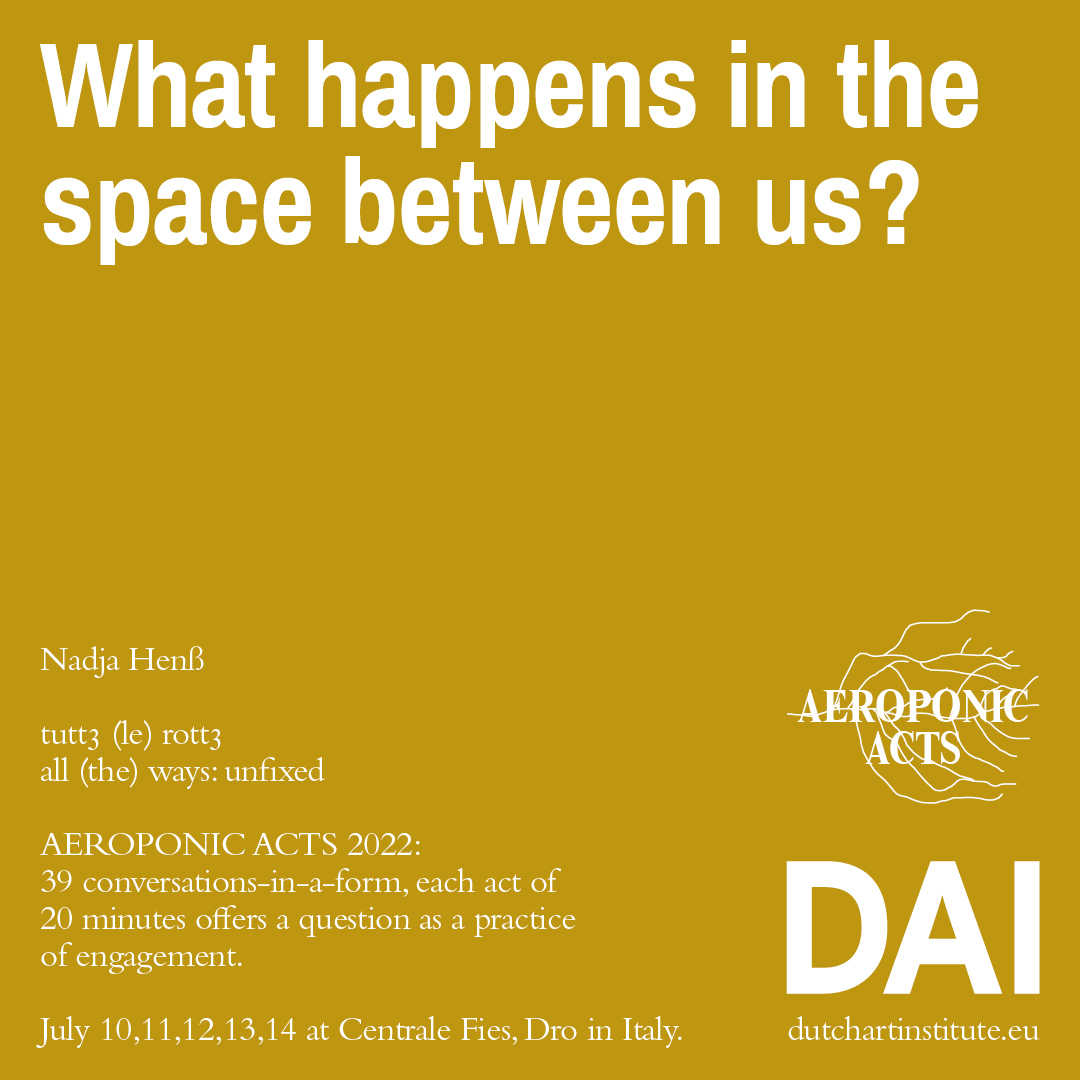Nadja Henß: The space in-between us
‘Aeroponic’ – root systems nourished by air – Acts is the name given to the nomadic Dutch Art Institute’s final Kitchen presentations. Each participant addresses one question, as a practice of engagement.
Here you will find the documentation of Nadja Henß's presentation as filmed by Baha Görkem Yalım. The written report is by Hubert Gromny and it includes a summary of the comments by esteemed guest respondents.
The space in-between us
Nadja's question: What happens in the space between us?
Nadja's introduction: We are curious
We are vulnerable
we mourn
we surrender
we cry
we let go
We share
and we retreat
We learn
and we get disappointed
That space in-between us is what makes me grow
I can feel it with my hands
From time to time one of us needs to hold it all alone
It is a whole world, our world, your eyes are part of my life
Sometimes the space expands into the infinite
shifting shape
contracting
The space can be hard and nervous like a beat
If it is that what I want to attend to
that space there
where we meet
that is so meaningful to me
Then I want to find more gestures and words
to mend and water it
Hubert's report: The audience is encouraged to sit on the floor in the circle on pillows. The room is empty. The voice of Nadja becomes present in the space as a song through speakers. Nadja enters the room from one side, revealing the source of the voice, while from the other side a second performer (Ronja Sommer) moves towards Nadja. Ronja engages in a dialogue with a song speaking about the notion of home. Both performers are moving around the space and their dialogue takes the form of a call and response. Questions such as “what is your name, what do you fear, darling let me know what do we do here” are posed. They get closer to each other, sit on the floor and repeat a few times in chorus “we cry and we let go in this space between us we mourn, surrender, cry and let go”. Nadja tries to lift and carry Ronja. Moving their bodies through the space, they both stumble, fall and try again. The performance continues with Nadja and Ronja engaging in different forms of dialogue through speech and movements of their bodies. At certain points they hold each other and start spinning, losing their balance and falling among the audience. Through these figures of speech and movement they dwell into various emotional states and attempts to support each other by listening, talking or dancing. The performance ends with them smiling to each other and leaving the stage together.
Momtaza Mehri drew attention to the use of the undetermined first person plural pronoun “we” within the presentation as an entry point to the performance. Momtaza spoke about different figures of failure being performed and observed that the presentation was dwelling into questions of how to live the world together through interpersonal complications, boundaries and barriers. Commenting on the call and response formula, she pointed out the method of mirroring used in a performance often broken by two bodies walking in different directions. As such the work was reflecting on the difficult labor of creating a relationship and indicated the negative capability to live with and reckon with the fear, pain and other difficulties evoked by a particular relationship. Momtaza noted that the piece felt alive as it did not offer resolution but rather allowed for the fullness and breadth of relation.
Phanuel Antwi commented on the position of the viewer as an outsider of the relationship presented in the performance. Phanuel pointed out the effort the audience has to make in order to stay committed to the first person plural pronoun “we” proposed in the performance. This poses a question of a desire of the audience—why one would want to be committed in looking at a certain set of relations and how it would be to take into consideration the possibility of the negative response of the audience. Phanuel suggested that contemplating on the notion of editing—in thinking of what is to be left out, and what can be concealed from the audience—could be a helpful strategy. He remarked on the importance for mindful movement and organization of the space, as a way of acknowledging that forming a relation oftentimes hurt people, who are outside of it. Phanuel added that for thinking about spaces in between differently, and in more complex ways, it will be useful to look into the work of a philosopher Willie Ermine, especially an essay “Ethical Space of Encounter”.
Chiara Figone commented on the staging of the space and how performers were moving between people as a reflection on how society is organized. At the same time the question of how we would like these spaces to be or how to shape spaces between us was not so present. While experiencing the performance Chiara was interested in adding another layer to it, which would acknowledge how active is a presence of each person in the room. The performance as the play of possibilities within the relationship was unfolding vulnerability, but only between bodies, which were conditioned as performing ones. Chiara noted that while we are sitting together the non-verbal communication happens between bodies, which seems not to act. Shifting attention to the space of this present—but not explicit–-communication, could potentially address the question of how to activate space between, how to unlearn certain vocabularies, ways of presenting biographies and telling stories. Thinking about that could allow to invent a less scripted language.
Nadja Henß's "The space in-between us" was presented before live audience at the Centrale Fies, Dro, Italy on July 11th.
Find the overview of all 24 AEROPONIC ACTS 2022 here: tuttə (le) rottə - all (the) ways: unfixed
About Nadja Henss


